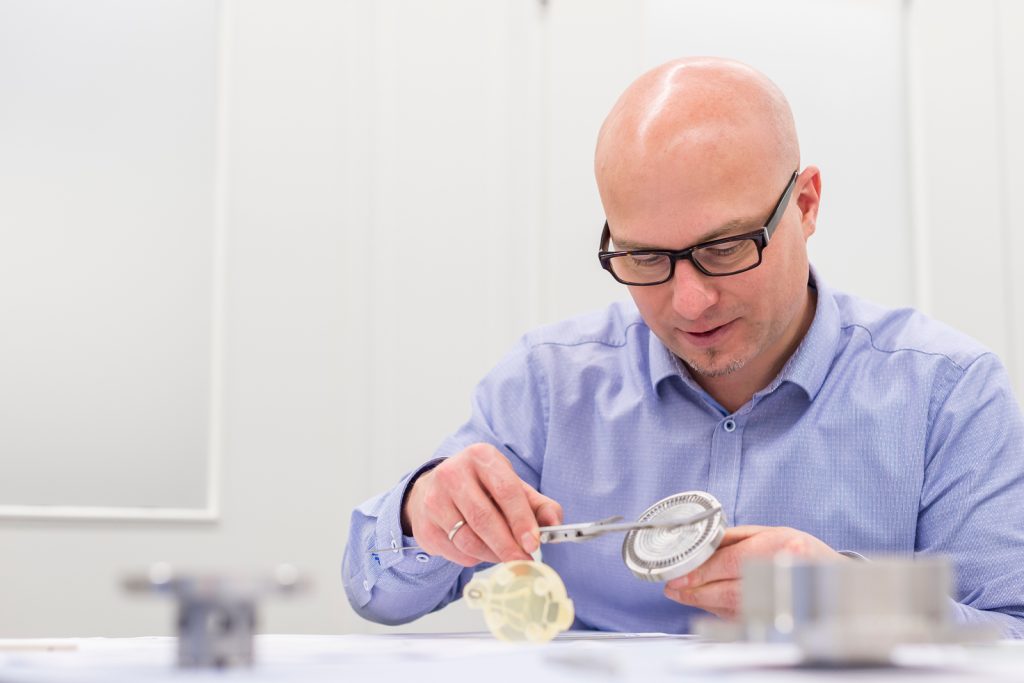For some time now, growing numbers of pharmaceutical companies are focusing more on distributing rather than researching and developing pharmaceuticals themselves. They are increasingly buying semi-finished or finished formulations from smaller companies or startups. The reasons for this are fairly obvious: The initial development of new drugs is laborious, cost-intensive and risky. Nobody knows whether there will be an approved and marketable drug at the end of the road. One of the more common stumbling blocks relates to process development, which may be inadequate or comes too late. Smaller companies often lack the necessary expertise and technical options for this task. Harro Höfliger has both: The specialists accompany and support customers with a bundle of services on their way to turning an idea into a product – quckly and with minimal risk. We’ll show you how such a shared journey proceeds by taking the example of an inhalable powder.

WHERE ARE WE HEADED?

Marco Laackmann, Sales Director Inhalation Technologies at Harro Höfliger
Marco Laackmann is one of THE inhalation experts at Harro Höfliger. As a sales representative, he is the first point of contact for customers in many cases. In his discussions it is important for him to understand the wishes or ideas and find out where the journey should actually go. “Sometimes there’s merely a concept, but often the customer already has a sample of the powder they’ve developed. We also have cases where the focus isn’t on the API but on the route of delivery, such as a novel inhaler. And then there are customers who need our support in developing the powder itself,” Laackmann explains. Regardless of the starting situation: Together with the customer and experts from Harro Höfliger, he focuses on process development at an early stage, thus setting the course for the success of their project.

HOW MUCH CONSULTATION is required?
Harro Höfliger offers customers an entire catalog of consulting services. These range from analyzing the powder components and the subsequent production of the mixture, to searching for an appropriate filling technology and a suitable inhaler, up to developing a high-performance line for commercial series production of the finished product.
 Regardless of whether customers go for individual consulting modules or the complete package: The risk of errors in early process development is reduced, which increases the chance of quickly bringing a viable drug to market that can be produced in large amounts.
Regardless of whether customers go for individual consulting modules or the complete package: The risk of errors in early process development is reduced, which increases the chance of quickly bringing a viable drug to market that can be produced in large amounts.

can the DESTINATION BE REACHED? AN INITIAL APPRAISAL
The first stop in process development is with Dr. Elke Sternberger-Rützel, Division Leader Pharma Services at Harro Höfliger. Together with her team, she ensures that each powder can be processed perfectly and ends up where it is supposed to: firstly in the primary packaging material and later in the patient’s lungs. Prior to starting the actual work, the safety datasheet of the API to be analyzed is reviewed and an identity test ensures that it matches the powder sample sent by the customer. The pharmacist then undertakes physical characterization of the powder.
 “Putting it simply, some are like sugar, so they’re flowable. Others are more like powdered sugar, so they’re cohesive, i.e. poorly flowable,” says Sternberger-Rützel. Based on the analyses, the Pharma Services team creates metrics and compares them with the reference powders available in large numbers at Harro Höfliger. “At this point,” Sternberger-Rützel explains, “we can already predict with a fair degree of confidence whether it is possible in principle to fill the powder on a large scale.”
“Putting it simply, some are like sugar, so they’re flowable. Others are more like powdered sugar, so they’re cohesive, i.e. poorly flowable,” says Sternberger-Rützel. Based on the analyses, the Pharma Services team creates metrics and compares them with the reference powders available in large numbers at Harro Höfliger. “At this point,” Sternberger-Rützel explains, “we can already predict with a fair degree of confidence whether it is possible in principle to fill the powder on a large scale.”

THE QUEST FOR THE PERFECT MIXTURE
One of the trickiest tasks in process development is mixing the API with excipients like lactose and possibly magnesium stearate. At the end of the day, the mixture must have optimum flowability and an even API distribution.

Dr. Elke Sternberger-Rützel, Division Leader Pharma Services at Harro Höfliger
To achieve this, Elke Sternberger-Rützel and her staff need a ton of patience: “The main parameters we look at are the constituents, as well as mixing speed and duration. We have to adapt both to the particular API, because not every API can tolerate high shear forces during mixing, for example.” Each mixing experiment is followed by sampling at ten different points. “Only when the same active substance concentration is present at each measuring point do we move on to the next step,” says the pharmacist.

TIME FOR GOING SEPARATE WAYS
The core principle of dry powder inhalers is that the patient inhales and the air flow makes the powder disperse. The finer fraction ends up deep in the lungs. So what had first been mixed with care and patience must now separate again perfectly. With the aid of numerous tests, the experts determine the ideal interaction of inhaler and API particles.
 The interaction must be just strong enough for the particles to adhere to each other during filling, but reliably separate from each other again during inhalation. “We have a Next Generation Impactor (NGI) for the tests, which works like an artificial lung,” Sternberger-Rützel explains. “With this device, we can accurately determine the aerodynamic particle size distribution during inhalation to ascertain whether the powder is separating as required.”
The interaction must be just strong enough for the particles to adhere to each other during filling, but reliably separate from each other again during inhalation. “We have a Next Generation Impactor (NGI) for the tests, which works like an artificial lung,” Sternberger-Rützel explains. “With this device, we can accurately determine the aerodynamic particle size distribution during inhalation to ascertain whether the powder is separating as required.”


THE SUITABLE PRINCIPLE
For each powder, it is necessary to select the suitable filling technology, of which there are around 15 at Harro Höfliger. Sternberger-Rützel says: “The amount of powder and the API concentration in every single dose must be perfectly suitable throughout, in small batches for clinical trials as well as for series production.”
 The Pharma Services team carries out filling experiments with a pre-selection of two or three filling technologies. “We first undertake experiments manually with tabletop instruments and start with filling the powder into capsules. If precise dosing can be demonstrated here, the process will also work dependably and reproducibly when filling into other devices and in large amounts. This gives customers peace of mind before they enter into major investments.”
The Pharma Services team carries out filling experiments with a pre-selection of two or three filling technologies. “We first undertake experiments manually with tabletop instruments and start with filling the powder into capsules. If precise dosing can be demonstrated here, the process will also work dependably and reproducibly when filling into other devices and in large amounts. This gives customers peace of mind before they enter into major investments.”

everything is possible now
Prior to and during the numerous analyses and tests that the powder has to undergo, experts from Harro Höfliger also advise customers on devices, on request. “We help turn ideas into real products,” Marco Laackmann explains, adding: “Here, too, we have the expertise and technical prerequisites to carry out sound experiments.” Elke Sternberger-Rützel, who documents all analysis and experimental results as well as the process parameters of the powder and makes them available to the customer, adds: “We take a holistic view of process development. Our approach is to bring formulation, device and filling technology together as early as possible to quickly arrive at the optimal process.”
 “The demand for consultation in process development is already high. And it is set to rise,” Laackmann is convinced. “For instance, with the growth of biotech drugs and APIs like inhalable antibodies or mRNA, entirely new development challenges arise for all involved. We will not abandon our customers on this path. We accompany them on request – from powder development to the construction of a commercial production line.”
“The demand for consultation in process development is already high. And it is set to rise,” Laackmann is convinced. “For instance, with the growth of biotech drugs and APIs like inhalable antibodies or mRNA, entirely new development challenges arise for all involved. We will not abandon our customers on this path. We accompany them on request – from powder development to the construction of a commercial production line.”

Download this article as PDF file
Photos: Andreas Dalferth
